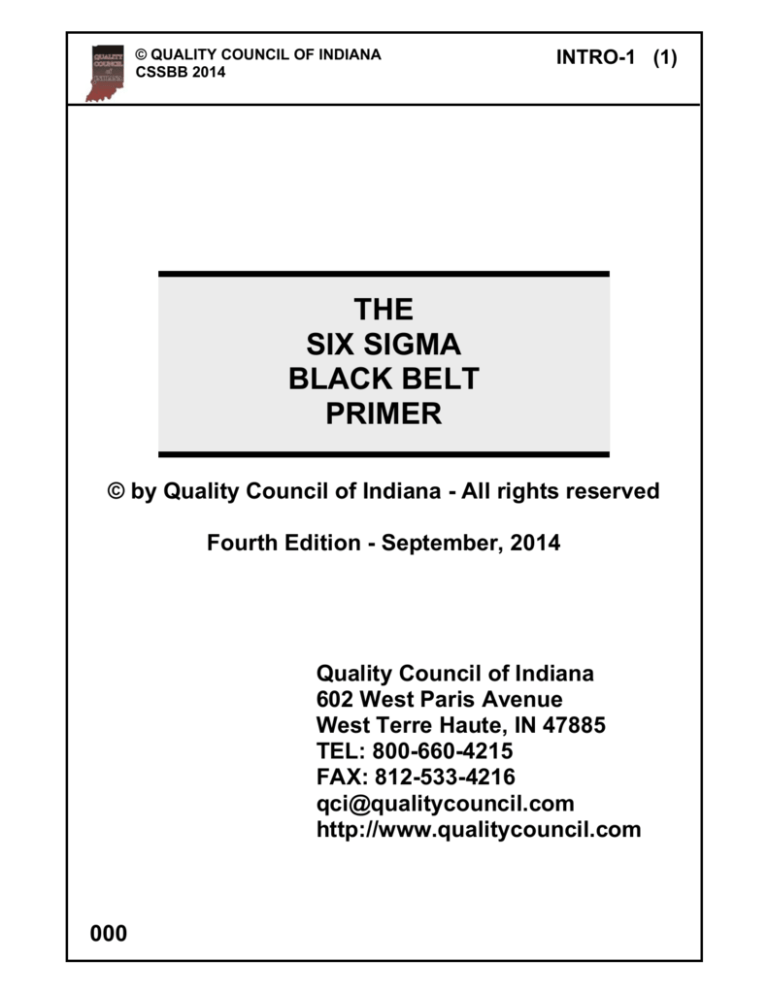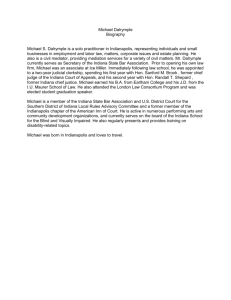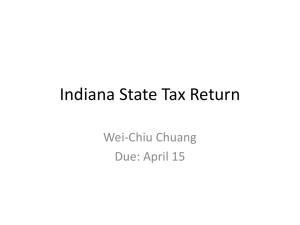
© QUALITY COUNCIL OF INDIANA
CSSBB 2014
INTRO-1 (1)
THE
SIX SIGMA
BLACK BELT
PRIMER
© by Quality Council of Indiana - All rights reserved
Fourth Edition - September, 2014
Quality Council of Indiana
602 West Paris Avenue
West Terre Haute, IN 47885
TEL: 800-660-4215
FAX: 812-533-4216
qci@qualitycouncil.com
http://www.qualitycouncil.com
000
© QUALITY COUNCIL OF INDIANA
CSSBB 2014
INTRO-7 (2)
CSSBB Primer Contents
I. CERTIFICATION OVERVIEW . . . . . . . . . . . . . . . . . I-1
CSSBB EXAM . . . . . . . . . . . . . . . . . . . . . . . . . . . . . I-3
CSSBB BODY OF KNOWLEDGE . . . . . . . . . . . . . . I-6
II. ENTERPRISE-WIDE DEPLOYMENT . . . . . . . . . . . II-1
ORGANIZATION-WIDE CONSIDERATIONS . . . . . II-2
SIX SIGMA/LEAN FUNDAMENTALS . . . . . . . . . II-2
IMPROVEMENT METHODOLOGIES . . . . . . . . II-34
SYSTEMS AND PROCESSES . . . . . . . . . . . . . . II-42
STRATEGIC PLANNING . . . . . . . . . . . . . . . . . . II-47
LEADERSHIP . . . . . . . . . . . . . . . . . . . . . . . . . . . . . II-57
ROLES AND RESPONSIBILITIES . . . . . . . . . . II-57
ORGANIZATIONAL ROADBLOCKS . . . . . . . . . II-63
III. PROCESS MANAGEMENT . . . . . . . . . . . . . . . . . III-1
OVERVIEW . . . . . . . . . . . . . . . . . . . . . . . . . . . . . . III-2
STAKEHOLDER IMPACT . . . . . . . . . . . . . . . . . . . III-8
CRITICAL REQUIREMENTS . . . . . . . . . . . . . . . . III-11
BENCHMARKING . . . . . . . . . . . . . . . . . . . . . . . . III-11
BUSINESS MEASURES . . . . . . . . . . . . . . . . . . . III-15
PERFORMANCE MEASURES . . . . . . . . . . . . III-15
FINANCIAL MEASURES . . . . . . . . . . . . . . . . . III-20
© QUALITY COUNCIL OF INDIANA
CSSBB 2014
III-16 (138)
III. PROCESS MANAGEMENT
BUSINESS MEASURES/PERFORMANCE MEASURES
II.C.1
Business Level Metrics
Business level metrics are typically financial (external)
and operational (internal) summaries for shareholders
and management.
Business (executive) level metrics comprise summaries
of detailed operations and financial results reported
monthly, quarterly, or annually.
© QUALITY COUNCIL OF INDIANA
CSSBB 2014
III-16 (139)
III. PROCESS MANAGEMENT
BUSINESS MEASURES/PERFORMANCE MEASURES
II.C.1
Operations Level Metrics
Six sigma provides new metrics for managing complex
operations. Business effectiveness measures track how
well products are meeting customer needs (external
focus). Breyfogle indicates that they should have a
longer-term perspective and reflect the total variation
that the customer sees.
Operational efficiency measures relate to the cost and
time required to produce the products. They provide
key linkages between detailed process measures and
summary business results, and help identify important
relationships and root causes.
© QUALITY COUNCIL OF INDIANA
CSSBB 2014
V-7 (320)
V. DEFINE
VOICE OF THE CUSTOMER/IDENTIFICATION
IV.A.1
External Customer Segmentation (Cont’d)
The consumer customer market differs from the
business market as follows:
C The consumer market has a large number of
customers
C The majority of consumer purchases are small in
actual dollar amounts
C The transaction is usually a simple purchase
C Most consumers are not very knowledgeable about
the product
C The supplier does not share proprietary information
with the consumer
© QUALITY COUNCIL OF INDIANA
CSSBB 2014
V-7 (321)
V. DEFINE
VOICE OF THE CUSTOMER/IDENTIFICATION
IV.A.1
External Customer Segmentation (Cont’d)
In contrast, the business customer acts in the following
manner:
C There are a very small number of business
customers
C The amount purchased per transaction is quite large
C The purchase is handled through specialized
personnel
C The customer may know more
requirements than the producer
about
the
C The supplier may allow the customer access to all
sorts of information
It is also important to look at the market for the next two
to five years and estimate how it will change and grow.
© QUALITY COUNCIL OF INDIANA
CSSBB 2014
V-8 (322)
V. DEFINE
VOICE OF THE CUSTOMER/IDENTIFICATION
IV.A.1
Customer Service
The customer driven company is beginning to emerge in
America. The public demands and expects better
quality products and service. One sample program
follows:
C
C
C
C
C
Listen to the customer and determine needs
Define a service strategy
Set standards of performance
Select and train the right employees
Recognize and reward accomplishment
There is the need to listen to the customer, provide a
vision, provide training, improve the process, find or
develop response metrics, and measure the results.
About 70% of customers who leave a company do so
because of service quality.
© QUALITY COUNCIL OF INDIANA
CSSBB 2014
V. DEFINE
VOICE OF THE CUSTOMER/IDENTIFICATION
V-8 (323)
IV.A.1
Customer Retention
Most organizations spend the bulk of their resources on
attaining new customers and smaller amounts on
retaining customers.
High customer satisfaction
numbers do not necessarily mean the company has
good customer retention and good customer loyalty. It
has been found that current customers are worth as
much as five times more than new customers. The cost
of retaining a current customer is only one-fourth the
cost of acquiring a new customer.
Another study showed that companies will boost profits
by about 100% by just retaining 5% more of their
customers.
© QUALITY COUNCIL OF INDIANA
CSSBB 2014
V-9 (324)
V. DEFINE
VOICE OF THE CUSTOMER/IDENTIFICATION
IV.A.1
Customer Retention (Continued)
Furlong lists some techniques for getting to know
customers better:
C
C
C
C
C
C
C
C
C
C
C
C
C
Don’t use your own instincts as data
See the world from the customer’s side
People high in the organization are out of touch
Get customers to talk
90% of unhappy customers won’t complain
Do research to retain customers
Determine how satisfied customers are
Conduct research on customer expectations
Develop a customer profile
Share the results of customer research studies
Don’t go overboard on the details and measurement
Coordinate and use research efforts
Understand that sometimes research does not help
© QUALITY COUNCIL OF INDIANA
CSSBB 2014
V. DEFINE
VOICE OF THE CUSTOMER/IDENTIFICATION
V-9 (325)
IV.A.1
Customer Loyalty
The value of a loyal customer is not measured on the
basis of one gigantic purchase, but rather on his/her
lifetime worth. Loyal customers account for a high
proportion of sales and profit growth. Customer
retention generates repeat sales, and it is cheaper to
retain customers. Customer loyalty is something that
must be demonstrated through an act of execution,
trust, or delightful service. Customers become partners.
VI-33 (473)
© QUALITY COUNCIL OF INDIANA
CSSBB 2014
VI. MEASURE - DATA
PROCESS CHARACTERISTICS/ANALYSIS TOOLS
Circle Diagrams (Continued)
4. ACT
1. PLAN
3. CHECK
2. DO
The PDCA Cycle
Precise, but
Biased
Unbiased, but
not Precise
Unbiased and
Precise
Bias and Precision Distinction
V.A.2
VI-34 (474)
© QUALITY COUNCIL OF INDIANA
CSSBB 2014
VI. MEASURE - DATA
PROCESS CHARACTERISTICS/ANALYSIS TOOLS
V.A.2
Circle Diagrams
On occasion, a circle diagram can help conceptualize
the relationship between work elements in order to
optimize work activities. Shown below is a hypothetical
analysis of the work load for a shipping employee using
a Venn (or circle) diagram.
Packing
0.30
Shipping
Data
Entry
0.20
0.04
Pulling
Stock
0.25
0.06
Making
CDs
0.10
© QUALITY COUNCIL OF INDIANA
CSSBB 2014
VII. MEASURE - STATISTICS
PROBABILITY/OTHER DISTRIBUTIONS
VII-43 (623)
V.E.2
Hypergeometric Distribution (Continued)
From a group of 20 products, 10 are selected at random
for testing. What is the probability that the 10 selected
contain the 5 best units?
N = 20, n = 10, d = 5, (N-d) = 15 and r = 5
n!
n
note
that
C
=
r
r!
n
r
!
5! 15!
5!10! 5!10!
15! 10!10!
P r =
=
= 0.0163 = 1.63%
20!
5!10! 20!
10!10!
C55 C15
5
P r =
20
C10
The mean and the variance of the hypergeometric
distribution are:
=
nm
N
m N - n
nm
=
1
N N - 1
N
VII-44 (624)
© QUALITY COUNCIL OF INDIANA
CSSBB 2014
VII. MEASURE - STATISTICS
PROBABILITY/OTHER DISTRIBUTIONS
V.E.2
Choosing A Discrete Distribution
Start
Modeling a rate with
no upper bound for the
number of successes?
Yes
Poisson
No
Binomial
Yes
Probability of success
same on all trials?
Yes
Fixed number of trials?
No
No
Hypergeometric
Negative
Binomial
No
Probability of success
the same on all trials
and number of
successes = 1?
Yes
Geometric
© QUALITY COUNCIL OF INDIANA
CSSBB 2014
VII-45 (625)
VII. MEASURE - STATISTICS
PROBABILITY/OTHER DISTRIBUTIONS
V.E.2
Bivariate Normal Distribution
The joint distribution of two variables is called a
bivariate distribution. Bivariate distributions may be
discrete or continuous.
The graphical representation of a bivariate distribution
is a three dimensional plot, with the x and y-axis
representing the independent variables and the z-axis
representing the frequency for discrete data or the
probability for continuous data.
A special case of the bivariate distribution is the
bivariate normal distribution shown below:
© QUALITY COUNCIL OF INDIANA
CSSBB 2014
VII-54 (637)
VII. MEASURE - STATISTICS
PROCESS CAPABILITY/CAPABILITY STUDIES
V.F.3
Identifying Characteristics
The identification of characteristics to be measured in a
process capability study should meet the following
requirements:
C The characteristic should be indicative of a key
factor in the quality of the product or process
C It should be possible to adjust the value of the
characteristic
C The operating conditions that affect the measured
characteristic should be defined and controlled
Selecting one, or possibly two, key dimensions provides
a manageable method of evaluating the process
capability. The characteristic selected may also be
determined by the history of the part and the parameter
that has been the most difficult to control.
Customer purchase order requirements or industry
standards may also determine the characteristics that
are required to be measured.
VII-55 (638)
© QUALITY COUNCIL OF INDIANA
CSSBB 2014
VII. MEASURE - STATISTICS
PROCESS CAPABILITY/CAPABILITY STUDIES
V.F.3
Identifying Specifications/Tolerances
The process specifications or tolerances are determined
either by customer requirements, industry standards, or
the organization’s engineering department.
Developing Sampling Plans
The appropriate sampling plan for conducting process
capability studies depends upon the purpose and
whether there are customer or standards requirements
for the study.
If the process is currently running and is in control,
control chart data may be used to calculate the process
capability indices.
If the process fits a normal
distribution and is in statistical control, then the
standard deviation can be estimated from:
R
R
d2
For new processes a pilot run may be used to estimate
the process capability. A design of experiments can be
used to determine the optimum values of the process
variables which yield the lowest process variation.
© QUALITY COUNCIL OF INDIANA
CSSBB 2014
VII-56 (639)
VII. MEASURE - STATISTICS
PROCESS CAPABILITY/CAPABILITY STUDIES
V.F.3
Verifying Stability and Normality
If only common causes of variation are present in a
process, then the output of the process forms a
distribution that is stable over time and is predictable.
If special causes of variation are present, the process
output is not stable over time.
The Figure below depicts an unstable process with both
process average and variation out-of-control. The
process may also be unstable if either the process
average or variation is out-of-control.
© QUALITY COUNCIL OF INDIANA
CSSBB 2014
VII. MEASURE - STATISTICS
PROCESS CAPABILITY/CAPABILITY STUDIES
VII-57 (640)
V.F.3
Verifying Stability and Normality (Cont’d)
The validity of the normality assumption may be tested
using the chi square hypothesis test. To perform this
test, the data is partitioned into data ranges. The
number of data points in each range is then compared
with the number predicted from a normal distribution.
Continuous data may be tested using a variety of
goodness-of-fit tests.
VII-58 (641)
© QUALITY COUNCIL OF INDIANA
CSSBB 2014
VII. MEASURE - STATISTICS
PROCESS CAPABILITY/CAPABILITY STUDIES
V.F.3
The Normal Distribution
When all special causes of variation are eliminated,
many variable data processes, when sampled and
plotted, produce a bell-shaped distribution. If the base
of the histogram is divided into six (6) equal lengths
(three on each side of the average), the amount of data
in each interval exhibits the following percentages:
68.27%
95.45%
:-3F
:-2F
:-1F
:
99.73%
:+1F
:+2F
:+3F
VII-58 (642)
© QUALITY COUNCIL OF INDIANA
CSSBB 2014
VII. MEASURE - STATISTICS
PROCESS CAPABILITY/CAPABILITY STUDIES
V.F.3
The Z Value
The area outside of specification for a normal curve can
be determined by a Z value.
ZLOWER
X - LSL
S
ZUPPER
USL - X
S
The Z transformation formula is:
Z=
X-
This transformation will convert the original values to
the number of standard deviations away from the mean.
The result allows one to use a single standard normal
table to describe areas under the curve (probability of
occurrence).
VII-59 (643)
© QUALITY COUNCIL OF INDIANA
CSSBB 2014
VII. MEASURE - STATISTICS
PROCESS CAPABILITY/CAPABILITY STUDIES
V.F.3
Z Value (Continued)
There are several ways to display the normal
(standardized) distribution:
1.
As a number under the curve, up to the Z value.
0
1.0
P(Z = - to 1) = 0.8413
2.
As a number beyond the Z value.
0
1.0
P(Z =1 to + ) = 0.1587
© QUALITY COUNCIL OF INDIANA
CSSBB 2014
VII. MEASURE - STATISTICS
PROCESS CAPABILITY/CAPABILITY STUDIES
VII-59 (644)
V.F.3
Z Value (Continued)
3. As a number under the curve, and at a distance from
the mean.
P(Z = 0 to 1) = 0.3413
The standard normal table in this Primer uses the
second method of calculating the probability of
occurrence.
© QUALITY COUNCIL OF INDIANA
CSSBB 2014
VII-60 (645)
VII. MEASURE - STATISTICS
PROCESS CAPABILITY/CAPABILITY STUDIES
V.F.3
Z Value Example
Tenth grade students weights follow a normal
distribution with a mean μ = 150 lb and a standard
deviation of 20 lb. What is the probability of a student
weighing less than 100 lb?
μ = 150
x = 100
σ = 20
X- μ
σ
100 - 150
50
Z=
== -2.5
20
20
Z=
Since the normal table has values about the mean, a Z
value of - 2.5 can be treated as 2.5.
P(Z = - to -2.5) = 0.0062. That is, 0.62% of the students
will weigh less than 100 lb.
VII-62 (646)
© QUALITY COUNCIL OF INDIANA
CSSBB 2014
VII. MEASURE - STATISTICS
PROCESS CAPABILITY / CAPABILITY INDICES
V.F.1
Capability Index Failure Rates
There is a direct link between the calculated Cp (and Pp
values) with the standard normal (Z value) table. A Cp of
1.0 is the loss suffered at a Z value of 3.0 (doubled, since
the table is one sided). Refer to the Table below.
Cp
0.33
0.67
1.00
1.10
1.20
1.30
1.33
1.40
1.50
1.60
1.67
1.80
2.00
Z
value
1.00
2.00
3.00
3.30
3.60
3.90
4.00
4.20
4.50
4.80
5.00
5.40
6.00
ppm
317,311
45,500
2,700
967
318
96
63
27
6.8
1.6
0.57
0.067
0.002
© QUALITY COUNCIL OF INDIANA
CSSBB 2014
VII-62 (647)
VII. MEASURE - STATISTICS
PROCESS CAPABILITY / CAPABILITY INDICES
V.F.1
Index Failure Rates (Continued)
In the prior Table, ppm equals parts per million of
nonconformance (or failure) when the process:
C
C
C
C
Is centered on X
Has a two-tailed specification
Is normally distributed
Has no significant shifts in average or dispersion
When the Cp, Cpk, Pp, and Ppk values are 1.0 or less, Z
values and the standard normal table can be used to
determine failure rates. With the drive for increasingly
dependable products, there is a need for failure rates in
the Cp range of 1.5 to 2.0.
X-12 (937)
© QUALITY COUNCIL OF INDIANA
CSSBB 2014
X. CONTROL
SPC/CONTROL CHART SELECTION
VIII.A.4
X̄ - R Control Chart
Product Name: Tablets
Variable: Removal Torques
1
Chart No. 1
Operator Bill
LBS
Process Closure Department
Specification Limits: LSL = 10 LBS USL = 22 LBS Units of Measure:
2
3
4
5
6
7
8
9
10
11
12
13
14
15
16
17
18
19
20
21
22
23
24
25
18
UCLX =17.5
17
run
16
X = 15.4
Averages
15
14
13
12
LCLX =13.3
special
special
11
10.5
special
8
Ranges
UCLR = 7.6
special
7
6
5
4
R = 3.6
3
2
1
0
Date Start 1/12/10
Time
Sample
Measurement
Total
Average x
Range R
1
2
3
4
5
LCLR = 0
1
2
3
4
5
6
7
8
9
10
11 12
13
14
15
16
18 19
20
21
22
23
24
25
1/13
1/12
7:05 7:10 7:35 8:10
12 15
12 17
13 16
15 17
12 18
64 83
12.8 16.6
3
3
17
13 10
18 12
14 11
14 10
15 11
74 54
14.8 10.8
2
5
8:15 9:10 9:12 9:33 11:40 11:43 12:05 13:05 13:45 13:55 14:20 14:55 7:00 7:55 9:00 9:12 9:32
13 15
16 12
14 13
15 15
14 11
72 66
14.4 13.2
3
4
15
16
15
16
15
77
15.4
1
15
17
16
14
12
74
14.8
5
22
17
15
17
14
85
17
8
16
15
17
15
18
81
16.2
3
16 15
18 16
16 17
16 17
16 14
82 79
16.4 15.8
3
2
17 16
15 15
16 18
15 18
16 16
79 83
15.8 16.6
3
2
17 19
19 17
17 15
15 15
17 17
85 83
17 16.6
4
4
16
19
16
15
14
16
15
17
16
18
80 82
16 16.4
5
3
19
18
17
15
16
76 85
15.2 17
4
4
17
13
17
15
14
14
17
16
14
13
74
14.8
4
This start up process smoothed out from data set 10 on.
The chart would need new control limits from that point.
X-35 (962)
© QUALITY COUNCIL OF INDIANA
CSSBB 2014
X. CONTROL
SPC/CONTROL CHART ANALYSIS
VIII.A.6
Control Chart Interpretation
Five Common Rules
(Rule 2) 4 out of 5
points in zone B
(Rule 4) 8 or more consecutive
points on one side of center line
UCL
Zone A
Zone B
Zone C
Zone C
Zone B
Zone A
(Rule 3) 2
out of 3 points
(Rule 1) A point
beyond the control limit in zone A
UCL
(Rule 5) A trend is 6
or more consecutive points
increasing or decreasing
Comment: Some authorities say 7 or more consecutive points for both Rules 4 and 5.
Other Unusual Patterns
UCL
Zone A
Zone B
Zone C
Zone C
Zone B
Zone A
(Rule 6) Stratification
15 or more points in zone C
(Rule 7) Mixture or
systematic variation
UCL
XII-8 (1055)
© QUALITY COUNCIL OF INDIANA
CSSBB 2014
XII. APPENDIX
Table V - t Distribution
tα
d.f.
t.100
t.050*
t.025**
t.010
t.005
d.f.
1
2
3
4
5
6
7
8
9
10
11
12
13
14
15
16
17
18
19
20
21
22
23
24
25
26
27
28
29
inf.
3.078
1.886
1.638
1.533
1.476
1.440
1.415
1.397
1.383
1.372
1.363
1.356
1.350
1.345
1.341
1.337
1.333
1.330
1.328
1.325
1.323
1.321
1.319
1.318
1.316
1.315
1.314
1.313
1.311
1.282
6.314
2.920
2.353
2.132
2.015
1.943
1.895
1.860
1.833
1.812
1.796
1.782
1.771
1.761
1.753
1.746
1.740
1.734
1.729
1.725
1.721
1.717
1.714
1.711
1.708
1.706
1.703
1.701
1.699
1.645
12.706
4.303
3.182
2.776
2.571
2.447
2.365
2.306
2.262
2.228
2.201
2.179
2.160
2.145
2.131
2.120
2.110
2.101
2.093
2.086
2.080
2.074
2.069
2.064
2.060
2.056
2.052
2.048
2.045
1.960
31.821
6.965
4.541
3.747
3.365
3.143
2.998
2.896
2.821
2.764
2.718
2.681
2.650
2.624
2.602
2.583
2.567
2.552
2.539
2.528
2.518
2.508
2.500
2.492
2.485
2.479
2.473
2.467
2.462
2.326
63.657
9.925
5.841
4.604
4.032
3.707
3.499
3.355
3.250
3.169
3.106
3.055
3.012
2.977
2.947
2.921
2.898
2.878
2.861
2.845
2.831
2.819
2.807
2.797
2.787
2.779
2.771
2.763
2.756
2.576
1
2
3
4
5
6
7
8
9
10
11
12
13
14
15
16
17
18
19
20
21
22
23
24
25
26
27
28
29
inf.
* one tail 5% α risk
** two tail 5% α risk
XII-12 (1059)
© QUALITY COUNCIL OF INDIANA
CSSBB 2014
XII. APPENDIX
Table IX - Control Chart Factors
CHART FOR
AVERAGES
Sample
Observations
Control limit
Factors
CHART FOR STANDARD
DEVIATIONS
Center
Line
Factors
Control Limit
Factors
CHART FOR RANGES
Center
Line
Factors
Control Limit
Factors
n
A2
A3
c4
B3
B4
d2
D3
D4
2
1.880
2.659
0.7979
0
3.267
1.128
0
3.267
3
1.023
1.954
0.8862
0
2.568
1.693
0
2.574
4
0.729
1.628
0.9213
0
2.266
2.059
0
2.282
5
0.577
1.427
0.9400
0
2.089
2.326
0
2.114
6
0.483
1.287
0.9515
0.030
1.970
2.534
0
2.004
7
0.419
1.182
0.9594
0.118
1.882
2.704
0.076
1.924
8
0.373
1.099
0.9650
0.185
1.815
2.847
0.136
1.864
9
0.337
1.032
0.9693
0.239
1.761
2.970
0.184
1.816
10
0.308
0.975
0.9727
0.284
1.716
3.078
0.223
1.777
15
0.223
0.789
0.9823
0.428
1.572
3.472
0.347
1.653
20
0.180
0.680
0.9869
0.510
1.490
3.735
0.415
1.585
25
0.153
0.606
0.9896
0.565
1.435
3.931
0.459
1.541
X R Charts
X S Charts
CL x x A 2 R
CL x x A 3 S
UCLR D4 R
UCLR B4 S
LCLR D3 R
LCLR B3 S
Approximate capability
Approximate capability
R
d2
S
c4







